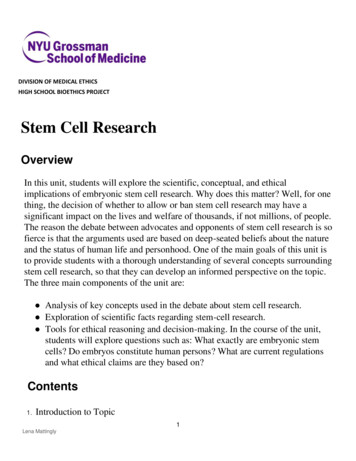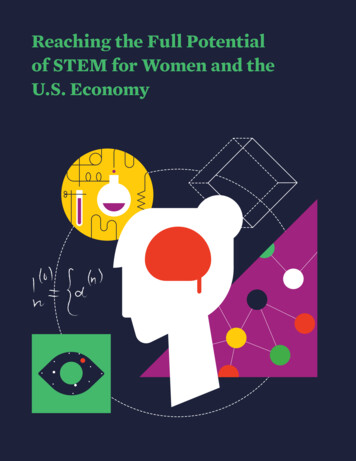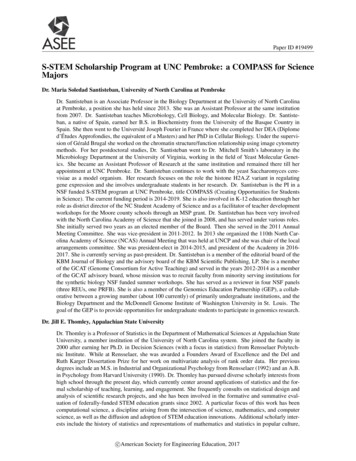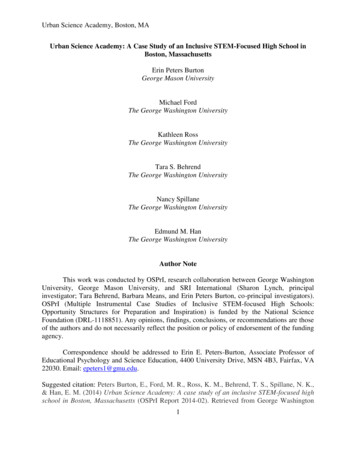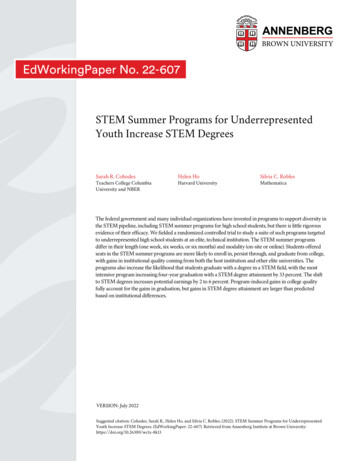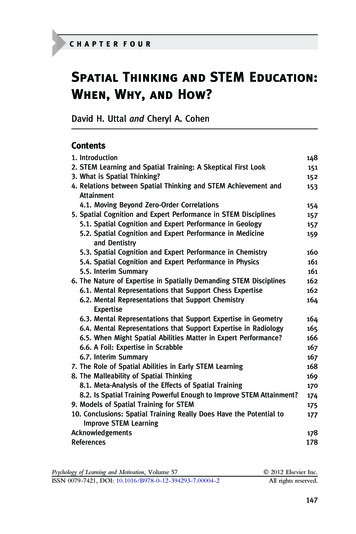
Transcription
Improving High Schools through STEM EarlyCollege StrategiesJune 2019The Impact of the STEM Early CollegeExpansion Partnership (SECEP)June 30, 20195900 Summit Ave.#201Browns Summit, NC 27214www.serve.org
IMPROVING HIGH SCHOOLS THROUGH STEMEARLY COLLEGE STRATEGIES:THE IMPACT OF THE STEM EARLY COLLEGE EXPANSIONPROJECTPrepared by:Dr. Julie EdmundsDr. William N. DudleyDr. Bryan C. HutchinsDr. Nina ArshavskyDr. Karla LewisSERVE Center at UNCGContact:Dr. Julie Edmunds, Program Director336-315-7415jedmunds@serve.org
Copyright NoticeCopyright 2019. The material within this report may not be reproduced or replicated withoutwritten permission from SERVE Center at the University of North Carolina at Greensboro.For permission, contact: Julie Edmunds at jedmunds@serve.org; 336-315-7415Suggested citation:Edmunds, J. A., Dudley, W.N., Hutchins, B.C., Arshavsky, N., & Lewis, K. (2019). Improving HighSchools through STEM Early College Strategies: The Impact of the STEM Early CollegeExpansion Partnership (SECEP). Greensboro, NC: The SERVE Center, University of NorthCarolina at Greensboro.Disclaimers:This work has been supported by the U.S. Department of Education’s Investing in Innovationprogram, through Grant #U411B130043 to Columbia University. The opinions expressed arethose of the authors and do not represent the views of the U.S. Department of Education, theInstitute of Education Sciences or other individuals within the University of North Carolina atGreensboro, Columbia University, Jobs for the Future or the Middle College NationalConsortium.This evaluation report used data collected and maintained by the Michigan Department ofEducation (MDE) and/or Michigan’s Center for Educational Performance and Information(CEPI). Results, information and opinions solely represent the analysis, information andopinions of the author(s) and are not endorsed by, or reflect the views or positions of, grantors,MDE and CEPI or any employee thereof.
ACKNOWLEDGEMENTSWe wish to thank Elisabeth Barnett, Jackie Ancess, Fenot Aklog, Emily Riddles, and Jennifer Kimfrom Teachers College, Columbia University, LaVonne Sheffield and Caesar Mickens from theJobs for the Future, Cece Cunningham from the Middle College National Consortium, and CheryWagonlander from the Michigan Early/Middle College Association for their time and assistancewith data collection. We would also like to thank Erika Bolig from the Michigan Department ofEducation and Melissa Bisson from the Michigan Center for Education Performance andInformation for their assistance with the Michigan student-level data. We also would like tothank the district leaders, principals, teachers, staff and students, who participated in thesurveys and interviews. We are grateful to Melissa Williams for editorial assistance.
BACKGROUND INFORMATION ABOUT THE SERVE CENTERThe SERVE Center at the University of North Carolina at Greensboro (UNCG) is a universitybased research, development, dissemination, evaluation, and technical assistance center. Itsmission is to support and promote teaching and learning excellence in the K-12 educationcommunity.Since its inception in 1990, SERVE has been awarded over 200 million in contracts and grants.It has successfully managed 14 major awards including four consecutive contracts for theRegional Educational Laboratory for the Southeast (REL-SE) funded by the Institute of EducationSciences (IES) at the US Department of Education (USED) and four awards from USED for theNational Center for Homeless Education (NCHE). In addition, past SERVE awards include a fiveyear Technology Grant for Coordinating Teaching and Learning in Migrant Communities, threeconsecutive contracts as the Eisenhower Consortium for Mathematics and Science Educationfor the Southeast, and two consecutive Regional Technology in Education Consortium grants.At the national level, SERVE operates the National Center for Homeless Education (NCHE),USED’s technical assistance and information dissemination center in the area of homelesseducation. NCHE uses state-of-the-art technology for web communication and onlineprofessional development and for supporting state coordinators of homeless education, localprogram coordinators, educators, parents, and advocates in all 50 states and in 15,000 schooldistricts.In addition to national-level NCHE activities, SERVE currently conducts research studies andevaluations under grants and contracts with federal, state, and local education agencies.Examples of SERVE’s grant-funded research work include three federally funded studies of theimpact of Early College High Schools and a five-year study of the impact of dual enrollment inCarolina. Contract work includes evaluations of four Investing in Innovation (i3) projects, theWinston-Salem/Forsyth County Magnet Program in North Carolina, the Guilford County Schoolsteacher incentive program (Mission Possible), the USED-funded Bridges to Early LearningProject in South Carolina, and North Carolina’s Race to the Top Initiative. The Guiding Principlesfor Evaluators (American Evaluation Association, 2004) and the What Works ClearinghouseStandards (Institute of Education Sciences, October, 2017) guide the evaluation workperformed at the SERVE Center.
TABLE OF CONTENTSSection I: Introduction and Overview . 1Section II: The STEM Early College High School Model and its Supports . 3STEM Early College High School Model . 3Implementation Supports . 4SECEP Logic Model . 8Section III: Evaluation Methodology . 10Examining Impact on Schools’ Implementation of the STEM Early College DesignPrinciples . 10Student Impact Study . 15Section IV: Implementation of the STEM Early College Design Principles . 16STEM College-Focused Academic Program (Design Principle #1) . 16Student Support (Design Principle #2). 31High School-College Collaboration (Design Principle #3) . 36Culture of Continuous Improvement (Design Principle #4) . 40Summary of SECEP Impacts on Design Principles . 45Section V: Student Impacts—Michigan . 48Methodology. 48Impact on Enrollment in College Credit-Bearing Courses . 53Impact on College Credit Attainment . 55Changes Over Time . 56Exploring Sub-Group Gaps . 57Impact on Dropouts . 59Perceptions of Impacts of the Program on Staff and Students . 59Section VI: Student Impacts—Connecticut . 64Methodology. 64Results . 66Perceptions of Impacts of the Program on Staff and Students . 67Section VIII: Discussion and Conclusion . 71Changes in Schools. 71Impacts on Students . 72References . 74Appendix A: Survey . 76Appendix B: Interview Protocols . 78Appendix C: Completed Pathways . 80Appendix D: Baseline equivalence by sub-group, michigan . 82Appendix E. Sub-Group Impacts, Michigan . 84
IMPROVING HIGH SCHOOL THROUGH STEM INSTRUCTION AND EARLY COLLEGE STRATEGIES:THE IMPACT OF THE STEM EARLY COLLEGE EXPANSION PARTNERSHIP (SECEP)SECTION I: INTRODUCTION AND OVERVIEWThe changing U.S. economy means that jobs that pay a living wage are more likely to requiresome form of postsecondary education, particularly in fields related to science, technology,engineering, or mathematics, known as STEM for short (Carnevale & Desrochers, 2003;Carnevale, Smith, & Strohl, 2010). Yet, concerns remain that too few students are successfullyearning postsecondary credentials, particularly in STEM areas. The problem is particularly acutefor certain populations of students, including low-income students, students who are the first intheir family to go to college, and students who are members of racial and ethnic groupsunderrepresented in college. In response to these concerns, educators and policymakers havebeen exploring a variety of approaches at the high school level to increase students’ interestand skills in STEM and to increase their likelihood of enrolling and succeeding in postsecondaryeducation.One of the most successful efforts to increase students’ enrollment and success inpostsecondary education has been the Early College. As originally conceptualized, Early Collegesare small schools focused purposefully on college readiness for all students. Frequently locatedon college campuses, Early Colleges target students who might face challenges inpostsecondary education. Early Colleges serve students starting in 9th grade; the goal is to havestudents graduate in four or five years, with a high school diploma and either a postsecondarycredential (usually an associate degree) or two years of transferable college credit. Supportedby an initial investment by the Bill and Melinda Gates Foundation, the small Early CollegeModel expanded across the country.This model has been the subject of three rigorous longitudinal experimental studies funded bythe U.S. Department of Education and led by SERVE Center at UNCG and an experimental studyconducted by the American Institutes of Research. These studies found that the Early CollegeModel had positive impacts on a variety of outcomes, including staying in school, progressing incollege preparatory courses, graduating from high school, and enrolling in and graduating fromcollege (Berger et al., 2013; Edmunds, Bernstein, Unlu, Glennie, & Smith, 2013; Edmunds et al.,2012; Edmunds, Unlu, et al., 2017; Edmunds, Willse, Arshavsky, & Dallas, 2013).As implemented, the Early College is not necessarily required to have a focus on STEM,although some Early Colleges have structured themselves around STEM themes. There is littleresearch, however, on how STEM can be successfully integrated into the Early College Model.Additionally, there is little research that indicates whether and how the small Early CollegeModel can be scaled to comprehensive high schools. Studies undertaken of two recent effortsto implement the model in comprehensive high schools have found that the schools can make1
some changes, although it is challenging work (Edmunds, Klopfenstein, Lewis, & Hutchins, 2018;Edmunds, Naumenko, Henson, & Hutchins, 2017). The STEM Early College ExpansionPartnership (SECEP) is among the first set of large-scale efforts to apply Early College strategiesin comprehensive high schools and the first one to attempt to simultaneously integrate STEMinstructional and curriculum changes.Supported by a 12 million grant from U.S. Department of Education’s Investing in Innovation(i3) Program, SECEP is designed to improve STEM education for 22,000 high-need middle and high school students,decreasing drop-out rates and boosting college enrollment in a number of districts inConnecticut and Michigan. SECEP will further improve underrepresented populations’access to STEM careers by increasing the number of students enrolling in dual creditSTEM courses and pursuing postsecondary credentials (SECEP Year 2 ManagementPlan).SECEP took place in two areas: Bridgeport, Connecticut and four intermediate school districts(ISDs) in Michigan. The project was a partnership between three primary organizations, eachwith a long history of Early College work. The overall effort was led by the National Center forRestructuring Education, Schools and Teaching (NCREST) at Teachers College, ColumbiaUniversity, collaborating with Jobs for the Future (JFF), and the Middle College NationalConsortium (MCNC). JFF was responsible for project implementation in Bridgeport, and MCNCwas responsible for project implementation in Michigan.SECEP set a bold goal for itself: 90% of students in SECEP schools would graduate high schoolwith some college credit. This goal was intended to promote broader change in the schools,focusing on four Design Principles that are described in more depth in Section II of the report.This report presents findings on the impact of this five-year project, including results for schoolsand students. The next section of the report describes the STEM Early College Model in moredetail. Section III includes the methodology used to assess the impacts on schools and anoverview of the student impact methodology. Section IV utilizes survey and interview data todescribe the impact of the project on schools. Because of differences in data availability thatimpacted the study design, student impacts for Michigan and Connecticut are reported inseparate sections. Section V describes the student impact analysis methodology and results forMichigan and Section VI describes the methodology and results for Connecticut. The reportends with key conclusions and lessons for educators to consider as they move forward with thiswork.2
SECTION II: THE STEM EARLY COLLEGE HIGH SCHOOL MODEL AND ITS SUPPORTSSECEP’s goal was to redesign high schools by focusing on STEM curriculum and instruction inschools while also expanding access to college courses for students. The project team did thisthrough supporting the implementation of the STEM Early College High School Model incomprehensive high schools.STEM Early College High School ModelThe STEM Early College High School Model, as articulated by NCREST and its partners, includedfour Design Principles: (1) a STEM College-Focused Academic Program, (2) Student Support, (3)High School-College Collaboration, and (4) a Culture of Continuous Improvement. To supportimplementation, the SECEP project staff developed a rubric that described implementation ofthese Design Principles. These Design Principles are described in this section and are alsooperationalized more fully in the section on school-level impacts.STEM College-Focused Academic Program (Design Principle #1)According to the SECEP Design Principles rubric, the first Design Principle was defined as:“Schools implement comprehensive, standards-based, STEM-focused curricula that provide abridge to STEM postsecondary studies.”One of the core expectations of the model was that students have access to college courseswhile in high school, with an emphasis on STEM-oriented pathways. Schools were expected toimplement a 4-5-year academic plan that included a sequence of STEM and non-STEM courses,preparing students for college and providing opportunities for college credit. The intent wasthat these pathways would give students a head start on specific college majors or preparestudents for careers, primarily focused on STEM. The project encouraged schools to createsystems that would allow students to earn at least 12 college credits by the time theygraduated from high school.In addition to curricular emphases, there was also an emphasis on changing instruction in twoareas: college readiness and STEM. Schools were expected to ensure that students were readyfor college courses by increasing the rigor of instruction and embedding key college preparatoryand college navigational skills into high school courses. Teachers were also expected to utilizeSTEM instructional practices, such as inquiry-based learning and problem- and project-basedlearning.Student Support (Design Principle #2)Under this Design Principle, “Supports are offered to all students to meet their academic, social,and emotional needs in high school and the transition to college.” This Design Principle3
recognizes that the rigor of the student experience cannot be increased without accompanyingsupports that will help students be successful.The expectation was that each school would develop a system of supports tied to students’needs and their academic progression. As noted in the rubric, “High schools support students:(1) to stay on track academically, (2) to prepare for college, (3) in STEM coursework, (4) incollege coursework, (5) in meeting socio-emotional needs.” These supports also includedcounseling relative to career readiness and to expose students to STEM careers.High School-College Collaboration (Design Principle #3)The Early College Model also depends on close collaboration between the district and itscollege partner(s), including ongoing communication and shared resources. According to therubric, “High schools and colleges take joint responsibility for students’ educational success.”Each school or district was expected to have a formal Memorandum of Understanding with atleast one college partner that delineated roles and responsibilities for each partner. There werealso expectations regarding ongoing communication between the partners and continuingcollaboration around courses and supports.Culture of Continuous Improvement (Design Principle #4)The fourth Design Principle includes an emphasis on using data to make decisions as well asaligning the high school and postsecondary curriculum: “High schools and colleges engage inevidence-based discussions to continuously improve students’ experiences and outcomes.”The intent was that each school create processes by which data were being used to informinstruction. Additionally, schools were expected to offer teachers regular and ongoingprofessional development related to the goals of the project and support ongoing teachercollaboration.Implementation SupportsTo support implementation of the STEM Early College Model in school, SECEP partners provideda suite of services including: (1) leadership coaching to districts, (2) workshops and conferences,(3) a Community of Practice, (4) school-based SECEP coaching, (5) district-level teams, and (6)district-college collaboration. Each is described in more depth below.Leadership Coaching to Districts (Implementation Support #1)Staff from the SECEP partners (JFF in Bridgeport and MCNC in Michigan) provided leadershipcoaching and technical assistance to districts to help them develop the capacity to plan,monitor, and implement the STEM Early College Model in their district. Part of this technicalassistance included support around the development of an implementation plan that aligned4
the multiple initiatives within each district and training for individuals who would serve asSECEP coaches directly to the schools.Data collected for the evaluation indicate that leadership coaching and technical assistance tothe districts took various forms: monthly meetings with key district representatives, assistancewith developing a strategic plan, individual coaching for district staff, collecting data during sitevisits, reviewing data with districts leaders, problem solving, monitoring implementation,developing annual plans, and developing workshops.All districts were provided with a template to complete annual plans intended to guide projectimplementation. District staff noted in their reports that they worked with project teams onthese plans. The plans (1) focused on the SECEP Design Principles; (2) examined theimplementation process, professional development needs, school structures, and resources; (3)named persons accountable for implementation; and (4) used evidence to show whether theyhad achieved their goals.The project staff also worked with district staff to support collaboration between the districtsand their college partners; more specifically, the development of academic plans, curricula,course sequences, scope and sequences, and STEM pathways.The expectation was that each district would receive an average of 22 contacts annually. Thisexpectation was met each year and, in many cases, substantially exceeded. For example, onaverage, in the fourth year of implementation, the project staff had over 165 substantivetechnical assistance interactions with the district staff, although there was substantial rangeacross districts from a low of 34 interactions in one district to a high of 432 in another.Workshops and Conferences (Implementation Support #2)Training is seen as an important part of implementation, providing people exposure toimportant information (Fixsen, Naoom, Blase, Friedman, & Wallace, 2005). SECEP partnersprovided workshops and conferences that focused on different components of the STEM EarlyCollege Model. Participants from both states attended the MCNC Summer Institute annually. Atthat conference, the SECEP districts brought a team and attended sessions focused ondeveloping Early/Middle College Programs, academic support for students, instructionalstrategies, and analysis of SECEP data. This conference also provided teams time to reflect onthe previous year and begin planning for the next academic year. Each state also had their ownregional/state conferences that included topics such as: implementing project-based learning,instructional strategies, developing effective lessons, implementing engineering thinking andsignature pedagogical approaches to STEM instruction, and assessment.A key activity during the national and state conferences was modeling the use of data to guideprogram improvement. NCREST staff collected and analyzed formative data to share with the5
districts and schools on an ongoing basis. These formative data consisted of a student survey,publicly available data, outcomes data, and college enrollment data, and the staff survey resultsfrom the external evaluation. The NCREST team facilitated data discussions with the schools,helping them understand how the data could inform their work.Finally, there were professional development opportunities at the local level that werescheduled according to needs identified by the schools and districts. These opportunities wereprovided by a range of individuals and groups, including local teachers or administrators,district staff, Teachers College professors/staff, or external organizations that provided relevanttraining. The topics primarily focused on STEM instruction and included science and mathintegration, integrating technology, instructional rounds, and inquiry science training.Participants in the professional development included both district and school staff, who were,respectively, expected to participate in at least five days of professional development annually.This expected level was met or exceeded each year. For example, in the fourth year ofimplementation, district teams participated in an average of 27 days of professionaldevelopment with participation ranging from a low of 10 days in one district to a high of 80 inanother. School teams participated in an average of 14 days of professional development with alow of 6 and a high of 39 days.Community of Practice (Implementation Support #3)One of the project’s supports was the creation of a common, online Community of Practice(COP) where resources and ideas could be shared across states and districts. The website thathosts this community was launched in December 2015 by JFF; it provided links to resources,experts, webinars, and calendars relevant to the SECEP project. The site represented the onlinecommunity of districts involved in SECEP as well as other districts doing Early College reformunder JFF guidance. As part of the COP, JFF staff and their guest presenters delivered a series ofwebinars focused on topics such as project-based learning, technology integration, growing thenumber of dual enrollment teachers, data use, redesigning the high school experience, schoolculture, work-based learning, and instructional coaching. The COP has archived these webinarsand other resources on topics such as coaching, instructional practices, and sustainability.School-Based SECEP Coaching (Implementation Support #4)Another key support was the provision of SECEP coaching services directly to the schools.Coaching that follows up on professional development is important to the success of programimplementation (Fixsen, Blase, Naoom, & Wallace, 2009; Joyce & Showers, 2002). Intended toprovide support around implementation of the SECEP Model, SECEP coaching was structuredvery differently in the two states.6
In Bridgeport, the model included a JFF instructional coach, a JFF leadership coach, coachesfrom Teachers College, and district- and school-based coaches. The JFF leadership coachworked with principals and their leadership teams in schools, reviewing data and progresstoward the SECEP deliverables. The JFF instructional coach worked with district staff, includingdistrict-based instructional coaches, and provided professional development and support. Thisinstructional coach worked with school staff on implementation of the Common InstructionalFramework, a set of six student-centered instructional practices designed to prepare studentsfor college. During the fourth year of the project, this coach also began working with schoolleaders. The coaches from Teachers College worked with school staff around implementedSTEM-focused instructional practices.Bridgeport also had school-based teacher leaders and instructional coach consultants. Theteacher leaders only worked in their home school. In Years 2 and 3, two district-levelconsultants each worked with three schools, providing support to six out of nine projectschools. However, by the middle of Year 4, there was only one district consultant working inthree project schools.In Michigan, the coaching was carried out by staff from the Intermediate School District (ISD) orthe local district, who used a mix of training, technical assistance, and instructional coaching tosupport school staff. These staff members coached teachers at the school, facilitated SECEPschool team meetings, and brought additional resources. In addition to district support, all theISDs either employed someone to provide school-level instructional coaching full time or hadtheir teacher leaders providing coaching or assistance to other teachers. Across the ISDs, thecoaches were former or current classroom teachers and/or administrators familiar to the staff.When the schools did not have an internal coach, the ISD provided coaches that worked withthe professional learning teams and individual teachers as needed and facilitated leadershipmeetings.The expectation was that each school was to receive at least 12 coaching days annually in Years2 and 3, with a reduction in Year 4 to 10 days per high school and 2 days per middle school. Thisexpectation was not met for Year 2, but it was met for Years 3 and 4. In the fourth year ofimplementation, the high schools received an average of 19 days of coaching support with theamount ranging from 6 to 34 days. The middle schools received an average of 10 days ofcoaching, ranging from a low of 2 days to a high of 34 days.District-Level SECEP Implementation Teams (Implementation Support #5)Having a core group of individuals who meet together regularly to support implementation isan important component of implementation (Meyers, Durlak, & Wandersman, 2012). Each ISDor district was expected to create a SECEP team that would serve as an organizing structure forimplementation. Each district created teams which met regularly and discussed grant-related7
issues such as information on relevant professional development, and general district or statepolicy that might impact the SECEP work. In interviews, respondents noted that the SECEP teamwas an important implementation tool, which (1) provided networking and support to schooland district leaders, (2) helped to share information and served as a resource, (3) created asense of urgency and priority for the project, and (4) provided accountability for the schoolleaders.District-College Collaboration (Implementation Support #6)The final key suppor
The STEM Early College High School Model, as articulated by NCREST and its partners, included four Design Principles: (1) a STEM College-Focused Academic Program, (2) Student Support, (3) High School-College Collaboration, and (4) a Culture of Continuous Improvement. To support . implementation (STEM: College : Impact . College
